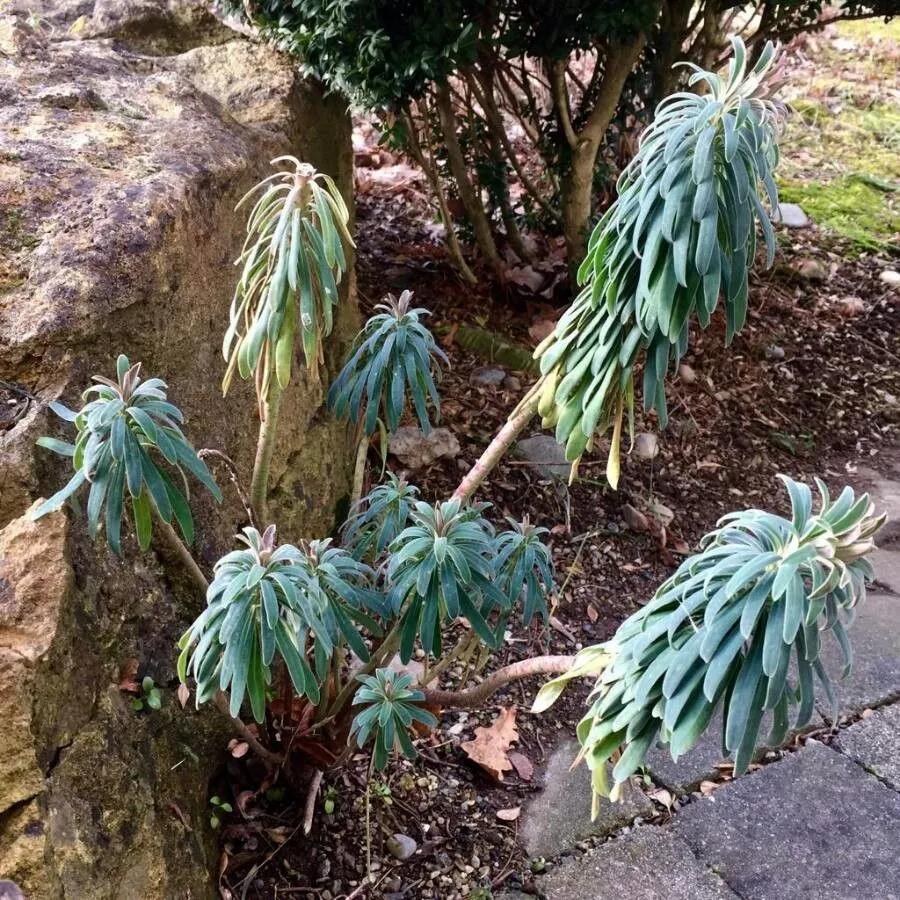
Author: L.
Bibliography: Sp. Pl.: 463 (1753)
Year: 1753
Status: accepted
Rank: species
Genus: Euphorbia
Vegetable: False
Observations: Medit.
The Mediterranean spurge, scientifically known as Euphorbia characias, is a distinctive and resilient perennial plant belonging to the Euphorbiaceae family. First documented in “Species Plantarum” in 1753 by the botanist Carl Linnaeus, this plant has since been a subject of interest due to its unique characteristics and adaptability to the Mediterranean climate.
Euphorbia characias is renowned for its striking architectural form, which can add a dramatic element to gardens and landscapes. It typically features robust, upright stems that can grow up to 1.5 meters tall, adorned with narrow, blue-green leaves. These leaves are densely arranged around the stems, giving the plant a lush, full appearance throughout the year.
One of the most captivating aspects of the Mediterranean spurge is its inflorescences. In late winter to spring, the plant produces large, dome-like clusters of bright yellow-green flowers. Each cluster consists of numerous small flowers, which are subtended by conspicuous, bright yellow bracts. This vivid display not only adds a splash of color to early-season gardens but also serves as an important nectar source for pollinators such as bees and butterflies.
In addition to its visual appeal, Euphorbia characias is highly valued for its low maintenance requirements. It thrives in well-drained soils and prefers full sun, making it an ideal choice for dry, sunny locations where other plants might struggle. Once established, it is notably drought-tolerant, requiring minimal watering which aligns well with sustainable gardening practices in Mediterranean climates.
However, it’s important to note that as with many plants in the Euphorbiaceae family, Euphorbia characias contains a milky sap that can be irritating to the skin and toxic if ingested. Gardeners are advised to handle the plant with care, wearing gloves and ensuring it is kept out of reach of pets and children.
In summary, Mediterranean spurge (Euphorbia characias) is a hardy, visually striking plant that enhances gardens with minimal care requirements. Its structural elegance, vibrant floral displays, and adaptability to dry climates make it a practical and aesthetic choice for gardeners looking to incorporate sustainable, drought-tolerant plants into their landscapes.
Eng: albanian spurge, mediterranean spurge
Deu: palisaden-wolfsmilch
Spa: caracias, euforbia encarnada, euforbia macho, hierba topera, lechetrezna encarnada, lechetrezna macho
Fra: euphorbe characias
Por: maleiteira-maior, titímalo-maior, trovisco, trovisco-macho
Nld: vroege wolfsmelk
Swe: daggtörel
Cym: llaethlys môr y canoldir
En: Mediterranean spurge, Albanian spurge, Large Mediterranean Spurge
Bg: Средиземноморска млечка
Ca: Bambollera, Bofeguera, Escampador, Herba del frare, Llet de Santa Teresa, Lleteresa gran, Lleteresa vera, Lleteresa vesquera, Lleteresa xera, Lletrera borda, Lletrera d’enviscar, Lletrera de muntanya, Lletrera de visc, Lletrera mascle, Xurrera, Lletrera vesquera
Nl: Vroege wolfsmelk
Fi: Vahatyräkki, Välimerentyräkki
Fr: Euphorbe characias, Euphorbe des garrigues, Euphorbe des vallons
De: Palisaden-Wolfsmilch, Characias-Wolfsmilch
El: Ευφορβία η χαρακίας
It: Euforbia cespugliosa
Pt: Maleiteira-maior, Titímalo-maior, Trovisco, Trovisco-macho
Es: Caracias, Lechetrezna encarnada, Lechetrezna macho, Euforbia encarnada, Euforbia macho, Hierba topera, Palmeteras
Sv: Daggtörel
Wa: Yebe ås rates
Cy: Llaethlys Môr y Canoldir
Taken Oct 4, 2018 by Dieter Wagner (cc-by-sa)
Taken Dec 21, 2017 by Creu Lopez (cc-by-sa)
Taken Dec 21, 2017 by Creu Lopez (cc-by-sa)
Taken Dec 4, 2019 by Dieter Wagner (cc-by-sa)
Taken Dec 28, 2018 by Dieter Wagner (cc-by-sa)
Taken Dec 4, 2019 by Dieter Wagner (cc-by-sa)
Taken Dec 4, 2019 by Dieter Wagner (cc-by-sa)
Taken Dec 23, 2018 by Dieter Wagner (cc-by-sa)
Taken Dec 4, 2019 by Dieter Wagner (cc-by-sa)
Taken Mar 26, 2019 by Pirrello Giorgia (cc-by-sa)
Taken Mar 27, 2010 by antonio (cc-by-sa)
Taken Mar 1, 2021 by Mat Linyer (cc-by-sa)
Taken Apr 14, 2017 by Juan Antonio Fernández de Cañete Costilla (cc-by-sa)
Taken Mar 7, 2018 by César Gonzalez (cc-by-sa)
Taken Jun 11, 2018 by mary lequin (cc-by-sa)
Taken Mar 4, 2021 by Martine Solana (cc-by-sa)
Taken Jun 7, 2021 by Alain Bigou (cc-by-sa)
Taken Jun 27, 2010 by Alain Lagrave (cc-by-sa)
Taken Jun 7, 2021 by Alain Bigou (cc-by-sa)
Taken Oct 25, 2021 by Gilles Istin (cc-by-sa)
Taken Nov 17, 2020 by Caminada Xavier (cc-by-sa)
Taken Dec 30, 2019 by Eleutherio (cc-by-sa)
Taken Feb 5, 2022 by Fabrice Rubio (cc-by-sa)
Taken Dec 28, 2021 by Jeff B (cc-by-sa)
Taken Oct 14, 2022 by Fabrice Rubio (cc-by-sa)
Taken Jan 30, 2021 by christophe gertner (cc-by-sa)
Taken Feb 8, 2021 by Patricia MARIN (cc-by-sa)
Taken Feb 1, 2022 by Jim Knopf (cc-by-sa)
Taken Jan 22, 2021 by Houmgaor (cc-by-sa)
Taken Mar 25, 2022 by alain antone (cc-by-sa)
© copyright of the Board of Trustees of the Royal Botanic Gardens, Kew.
Growth habit: Subshrub
Ph maximum: 7.5
Ph minimum: 7.0
Light: 7
Atmospheric humidity: 3
Soil nutriments: 5
Family: Myrtaceae Author: (F.Muell.) K.D.Hill & L.A.S.Johnson Bibliography: Telopea 6: 402 (1995) Year: 1995 Status:…
Family: Rubiaceae Author: Pierre ex A.Froehner Bibliography: Notizbl. Bot. Gart. Berlin-Dahlem 1: 237 (1897) Year:…
Family: Sapindaceae Author: Koidz. Bibliography: J. Coll. Sci. Imp. Univ. Tokyo 32(1): 38 (1911) Year:…
Family: Asteraceae Author: A.Gray Bibliography: Pacif. Railr. Rep.: 107 (1857) Year: 1857 Status: accepted Rank:…
Family: Fabaceae Author: Medik. Bibliography: Vorles. Churpfälz. Phys.-Ökon. Ges. 2: 398 (1787) Year: 1787 Status:…
Family: Aspleniaceae Author: (Cav.) Alston Bibliography: Bull. Misc. Inform. Kew 1932: 309 (1932) Year: 1932…